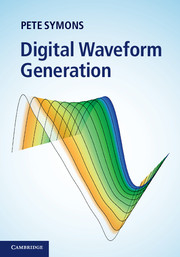Book contents
- Frontmatter
- Contents
- Preface
- Acknowledgements
- Glossary of terms
- 1 Introduction to waveform generation
- 2 The foundations of digital waveform generation
- 3 Recursive sine wave oscillators
- 4 DDS sine wave generation
- 5 DDS arbitrary waveform generation
- 6 Dynamic waveshape and spectrum control
- 7 Phase domain processing – DDS and the IDFT
- 8 Hardware implementation architectures
- 9 Digital to analogue conversion
- Index
- References
6 - Dynamic waveshape and spectrum control
Published online by Cambridge University Press: 05 November 2013
- Frontmatter
- Contents
- Preface
- Acknowledgements
- Glossary of terms
- 1 Introduction to waveform generation
- 2 The foundations of digital waveform generation
- 3 Recursive sine wave oscillators
- 4 DDS sine wave generation
- 5 DDS arbitrary waveform generation
- 6 Dynamic waveshape and spectrum control
- 7 Phase domain processing – DDS and the IDFT
- 8 Hardware implementation architectures
- 9 Digital to analogue conversion
- Index
- References
Summary
In this chapter we investigate several techniques for generating waveforms with time-varying waveshape and corresponding spectrum. We consider three distinct techniques which are inherently compatible with the DDS model:
paged wavetable access – where a contiguous sequence of waveform functions is tabulated in memory and accessed sequentially according to a time-varying waveshape (or spectrum) parameter;
linear wavetable combination – where multiple wavetables that each tabulate different waveform functions are linearly combined according to a time-varying parameter;
modulation – where the frequency, phase or amplitude of a typically sinusoidal carrier waveform is modulated by a modulator waveform.
Paged wavetable access requires a paged memory structure and provides time-varying waveshape (or corresponding spectrum) by selecting waveform ‘waypoints’ from a set of predefined wavetables. This is analogous to replaying a sequence of video frames where each frame represents a distinct waveform. In its most rudimentary form, the resolution of this technique is bound by the amount of physical memory available for wavetable storage and hence the number of distinct waveshape waypoints that may be included in a set. We also present an enhanced form called paged wavetable interpolation, which effectively interpolates waveforms that lie between the predefined waypoints, thus increasing the waveshape or spectrum control resolution. Waveshape may now be controlled in a piecewise-linear manner with arbitrarily fine control resolution according to a fractional page address.
- Type
- Chapter
- Information
- Digital Waveform Generation , pp. 228 - 248Publisher: Cambridge University PressPrint publication year: 2013

